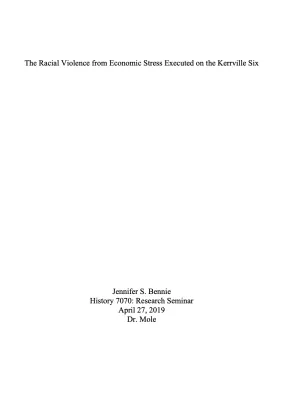
Western Tennessee, thirty years after the Civil War, was an area undergoing many
changes, all of them straining the racial and class relations of the people that lived in and around
the city of Kerrville. The crops being planted and harvested on the surrounding land had been on
a path of diversification for the past ten years. Cotton, which was once king of the area, was
steadily decreasing in price as the labor needed to sustain the crop was no longer an option.
Farmers sought to replace cotton with more cost-effective wheat or corn allowing for less manual
workers needed to toil and cultivate the land. The labor working the fields was now entirely cash
based, which increased tensions from the lowest rung of people on the working-class ladder.
The result was that poor blacks and poor whites were set in direct competition for the same
disappearing agricultural jobs, as farmers looked for who settled for the minimum wage they
could pay their field hands for labor. This led to conflict between the races. Then the loss of the
Kerrville Fair which also brought in extensive yearly revenue for the area only added to this
already tense racial and class situation. Racial hostility held over from the social hierarchy of
slavery led the white men in the Kerrville area to pursue their own justice with mob rule and
lynch law. They employed the use of violent “night riders” from years earlier against the black
community for control. The competition for wage agricultural labor in the working class as
cotton’s value fell burdened with the financial loss from the closing of the Kerrville Fair lead to
increased racial tensions in Shelby county less than thirty years after the Civil War which
climaxed in the vigilante lynching deaths of six black men from Kerrville.

Add comment